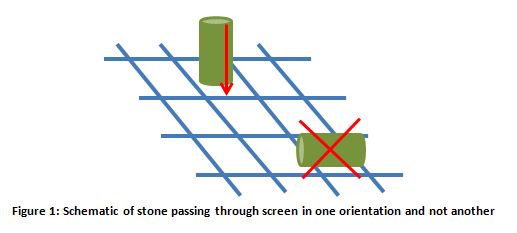The most common Gravelometer test method is SAE J400, which has existed since 1968 and has not changed much over time. Q-Lab’s gravel, part number G-699, does meet the requirements of SAE J400. The standard says:
“The gravel for this test shall be water-worn road gravel, not crushed limestone or rock. The gravel will pass through 15.86 mm (5/8 in) space screen when graded, but be retained on 9.53 mm (3/8 in) space screen.”
The standard requires that the gravel be screened between screen sizes of 3/8” and 5/8” (9.53 15.86 mm). Individual stones from natural gravel are oblong, and thus some of them will pass through one of the screens if oriented in one direction but not fit through the screen if oriented in another direction (See Figure 1). What the standard actually means is that the largest stones will have at least one dimension <5/8” and that the smallest stones will have at least one dimension >3/8”.

Additionally, Q-Lab gravel meets the requirements JIS A 5001 #6 and #7 gravel. Even though this standard has nothing to do with Gravelometer testing, some Japanese automotive OEMs have test methods that refer to it. Q-Lab’s gravel is screened to meet the requirements of JIA A5001 #6 and #7.
Additionally, although the standard does list basalt, it is not required. Q-Lab gravel uses crushed granite, which is very similar to basalt in mineral composition. Therefore, Q-Lab gravel meets the size and material requirements of this standard.
Due to settling during shipping and storage, larger stones will rise to the top of a container, so we suggest that for any test you shake or mix up the container before testing!